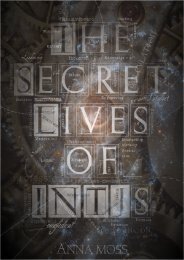Create successful ePaper yourself
Turn your PDF publications into a flip-book with our unique Google optimized e-Paper software.
and unprovable. Ni was, in fact, the most poorly differentiated cognitive function of all.<br />
Another interesting point is that the raters' agreed-upon descriptors for Ti seem to match<br />
INTJs better than the descriptors for Ni. Ti is, of course, the supposed dominant of<br />
INTPs/ISTPs.<br />
12 descriptors were found that primarily matched Ti. 320 The list was as follows: aloof, cold,<br />
desires internal logic, detached, in-depth concentration, independent, individualistic, likes<br />
mental models, overcomplexifies, pure intellectual, research-minded, and unique use of<br />
logic.<br />
These 12 descriptors fit type INTP, as would be expected since Ti is believed to be the<br />
INTP's dominant function. But as nearly as I can tell, all 12 descriptors match both INTPs<br />
and INTJs equally well. Following this logic, it would seem that Ti is a better dominant for<br />
INTJs than Ni. Then, only five of the Ti descriptors seem to fit type ISTP (aloof, cold,<br />
desires internal logic, independent, and individualistic). Ti is not the dominant of INTJs, yet<br />
the descriptors of Ti seem to fit both INTJs and INTPs to a tee. Ti is the dominant of ISTPs,<br />
yet the descriptors do not seem to fit type ISTP very well. Yet Ni, not Ti, is believed to be<br />
the dominant of the INTJ.<br />
What can we say about this? Even if one accepts that the cognitive functions exist, the<br />
murkiness and paucity of these descriptors must give one pause. The researchers also<br />
compared the descriptors for each cognitive function with data compiled on hundreds of<br />
typed people to see if they exhibited the traits said to be characteristic of their cognitive<br />
functions. Very little support for the theory of cognitive functions was found. There was no<br />
evidence that could not be more clearly, accurately, and simply explained by plain type<br />
theory without cognitive functions. Occam's razor dictates that the simplest explanation is<br />
most likely to be true.<br />
In the absence of both evidence and working definitions, it is hard to think of any logical reason to<br />
continue to use the cognitive functions. Ergo, I have left them out of this book.<br />
A Better Alternative<br />
One proposed replacement scheme (which I happen to agree with) drops type dynamics entirely. 321<br />
Instead, a person’s letters (i.e. INTJ) are ranked in order of “strength.” And what is meant by<br />
strength, exactly?<br />
Well, when you took the Myers-Briggs test (or any of the other MBTI knockoffs floating around)<br />
you probably noticed that some of your personality traits—i.e., Thinking, Feeling or whatever—<br />
were very clear and obvious, i.e. you answered 9/10 questions as a Thinker rather than a Feeler. For<br />
other personality traits, perhaps Sensing vs. Intuition, you might have noticed that you were pretty<br />
middle-of-the-road in that you didn’t have much preference for either way of functioning. For<br />
example, perhaps you only answered 6/10 questions as an Intuitive.<br />
In the traditional way of looking at type theory, it doesn’t matter whether your preference for any<br />
particular letter is clear or slight—a letter is a letter is a letter. If you answer 10/10 questions about<br />
Introversion vs. Extraversion as an Introvert, then it is considered the same thing as if you had<br />
320 However, for 5 of these 12 descriptors, secondary matches with Te, plain N, and Ni were found. In short, the<br />
surveyed experts thought that those five descriptors mainly matched Ti, but also secondarily matched Te, N, and<br />
Ni.<br />
321 Reyneirse, 2012




